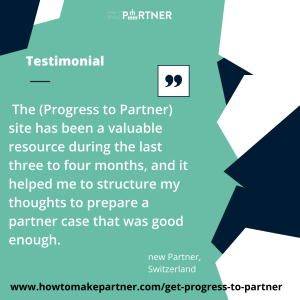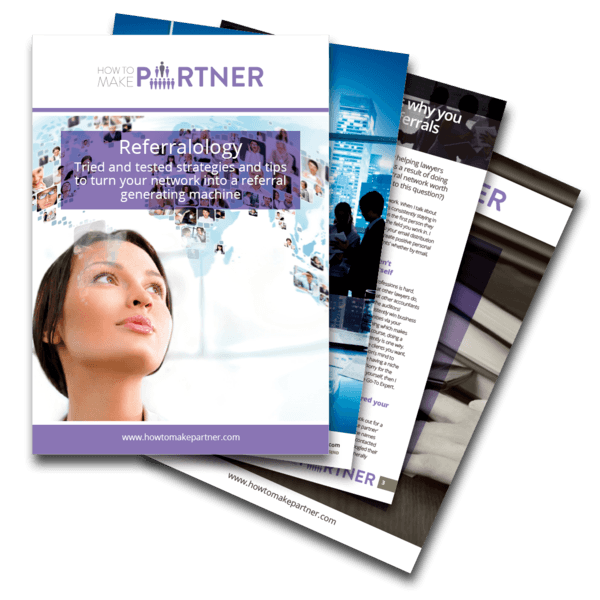The partnership admission process is shrouded in mystery. What is the process? What actually happens at an assessment centre? Is it the same in every firm? While this mystique helps to keep this esteemed partner image behind the curtain, the problem with mystery is that it often elicits fear. How can you prepare for something that you don’t even understand?
To help lawyers, accountants, and consultants gain more certainty about what the partnership admission process actually involves, this article gives you a concise overview. Here you will understand what the most common elements are in the process, what you need to pass each element, and how this differs between the Big 4 firms, law firms and mid-tier firms.
By the way, this article comes from a fragment of our Acing the Partnership Admissions Process Virtual Masterclass. The full recording (plus partnership admissions guides, templates and other advice are in the Progress to Partner Academy
If you listen to the whole of the virtual masterclass you will learn:
- 6 common mistakes people make on the partnership admissions process.
- 6 common elements of the partnership admissions process and how to pass each element.
- What your partners are really looking for in their future partners.
- How to get noticed for the right reasons and get put on the long list for partner track.
- How to create the time to be at your best as you go through the partnership admissions process.
The typical partnership admission process
 1. Big 4 firms and top mid-tier firms
1. Big 4 firms and top mid-tier firms
Top mid-tier firms have a partnership admissions process that is just as stringent as that of the Big 4 firms. What we mean by this is that the process is long and it is complicated. The goal for the talent team in big firms is to get the most amount of candidates for the partners to choose from which, as you can imagine, this gives more control to the partners.
So what does the process look like in big firms?
- Firstly, a business case for a new partner is identified 2-3 years out.
- Typically, 12 months before the partner admissions, candidates are long-listed.
- Informal Partner Panel Interviews then take place to see which candidates should be short-listed.
- Once they have a shortlist of candidates, the potential partners go through a series of stages over a 6-9 month period where it involves a combination of the following:
a. Submitting a Business Case application
b. Partnership Panel Interviews (at service and regional levels)
c. Technical Interview
d. Competency-based Interview
e. Case Study Interview (sometimes)
f. Assessment Centre (sometimes)
For more in-depth help with your business case, work through our course How to Build a Cast Iron Business Case for Partner. Find out more and get started here
 2. Law and mid-tier firms
2. Law and mid-tier firms
As you drop down a tier, the admission process follows a simpler and shorter structure. Naturally, as the partner pool is smaller, you don’t need extra steps to longlist and shortlist candidates so here is how the process differs to the Big 4 and top mid-tier firms:
- Firstly, a business case for a new partner is identified 1-2 years out.
- Once they have identified potential partner candidates, they then go through a series of stages over a 3-6 month period where it involves a combination of the following:
a. Submitting a Business Case application
b. A Partnership Panel Interview to the Partnership Promotions Committee
c. Technical Interview (sometimes)
d. Competency-based Interview (rarely)
e. Assessment Centre (rarely)
 3. Small firms
3. Small firms
When you get to the smaller firms, not surprisingly, the partnership admission process is a lot simpler than the higher tiers. In fact, it is very different from the other firms. In smaller firms, you tend to get a lot of situations where a partner is retiring, so then they start to think about who will be their replacement.
For example, this is the typical admissions process for a small firm:
- Firstly, a business case for a new partner is identified 3+ years out (the partner pool is a lot smaller and a case is usually identified as a direct result of succession).
- Potential partner candidates do a mixture of the following over a 3-6 month period:
a. Submitting a business plan (not always)
b. Presenting a business plan to the partners (not always)
As you can see, partner candidates in smaller firms need to present a business plan rather than a business case. This is because if they don’t have a tax partner, for example, they will want to know that you have solid tax practise there.
When it comes to ‘partner panel interviews’ too, smaller firms don’t always require a formal presentation. This is because, in a 5 partner firm, the decision for who makes partner is more about do we like them and can we work with them?
Note to Progress to Partner members: find out what it is that you want and exactly how to create a career plan in our ‘How to truly commit to moving your career forward’ workbook.’
For more in-depth help with your business case, work through our course How to Build a Cast Iron Business Case for Partner. Find out more and get started here
Common elements in the partnership admission process

Now that we’ve gone through what the typical partnership admission process involves (and how this differs between firms), I just want to touch on the most common elements of the process.
1. Formal Business Case submission
The business case is the most common element that the majority of partner candidates will have to submit. It is where you demonstrate the commercial promise of making you partner and persuade the partners to give up a slice of their profits. Unfortunately, this is not something that candidates are really trained on, so if you want to ace your business case, make sure you include the following:
- Executive summary
- Numbers: past, present and future
- 3-year overview of your business plan
- 12-month business development plan
- What are the Critical success factors?
- Answers to the questions: Why me? Why now?
(Need more help? Read: The 3 questions your business case for partnership needs to answer if you are to be successful).
Note to Progress to Partner members: if you need help with ‘Creating your cast-iron business case for partnership,’ work your way through the steps in the workbook.
For more in-depth help with your business case, work through our course How to Build a Cast Iron Business Case for Partner. Find out more and get started here
 2. Partnership Panel Interview
2. Partnership Panel Interview
The next most common element of the admissions process is the partnership panel interview where you will get 10-15 minutes to pitch your business case. The best way to structure your presentation is to use a 3-sentence pitch and to then decide on a 1-sentence sell that you can repeat to communicate your main message.
As well as creating a persuasive, engaging, and impactful presentation, you also have to get through the question and answer section on your business case too. To really be on your A-game throughout these interviews, you really need to practice and anticipate questions.(Read: How to be on your A-game during your partnership panel interview)
3. Assessment Centre
The assessment centre is one of the stages of the partnership admission process where candidates don’t really know what goes on or what to expect. To give you more clarity, here is what is typically carried out there and how you can perform at your best:
- Group Exercise – you won’t be able to prepare for this, it will be revealed to you what you need to do on the day.
- Case Study Interview – pick a business story that is in the news and start discussing the angles of it with your partner, peer, coach or mentor. Practice this and be ready to present and discuss it.
- Present Business Case – come up with a 3-sentence and 1-sentence sell for your business case. Practice and prepare for questions as much as you can.
- Psychometric Testing – these are normally weighted and where you will see what your strengths are and your development areas. You cannot be the perfect candidate here.
- Competency-based Interview – look through the competency framework of your firm and pick an example from your history where you have demonstrated this competency.
- Verbal/Numerical Reasoning Tests – you can buy or practice these kinds of test on the internet. If you’ve got these in the Assessment Centre, you can also ask them and they will point you towards some practice tests.
Sail through the admissions process

Hopefully, now the partnership admission process is not a scary unknown. Now, you should know the structure of the process at your firm, what the most common elements will be and how you can perform your best in each stage. Like with everything, when it comes to making partner, the most important things to do is start early, prepare aptly and practice, practice, practice.
If you do this (and you avoid the most common mistakes that candidates make in the process), you will stand out to the partners. You will emerge from this process a success!
For more on Acing the Partnership Admissions Process:
For more in-depth help with your business case, work through our course How to Build a Cast Iron Business Case for Partner. Find out more and get started here
Or join Progress To Partner Academy.








